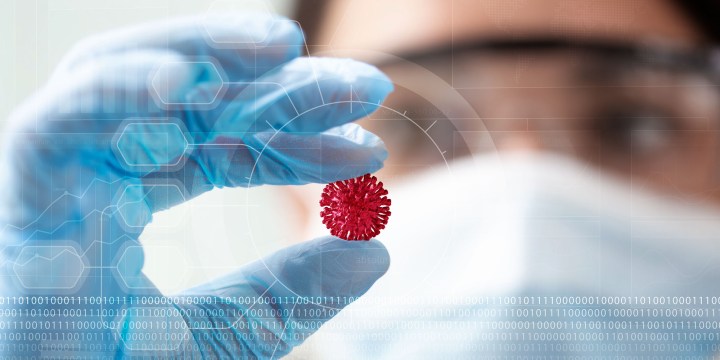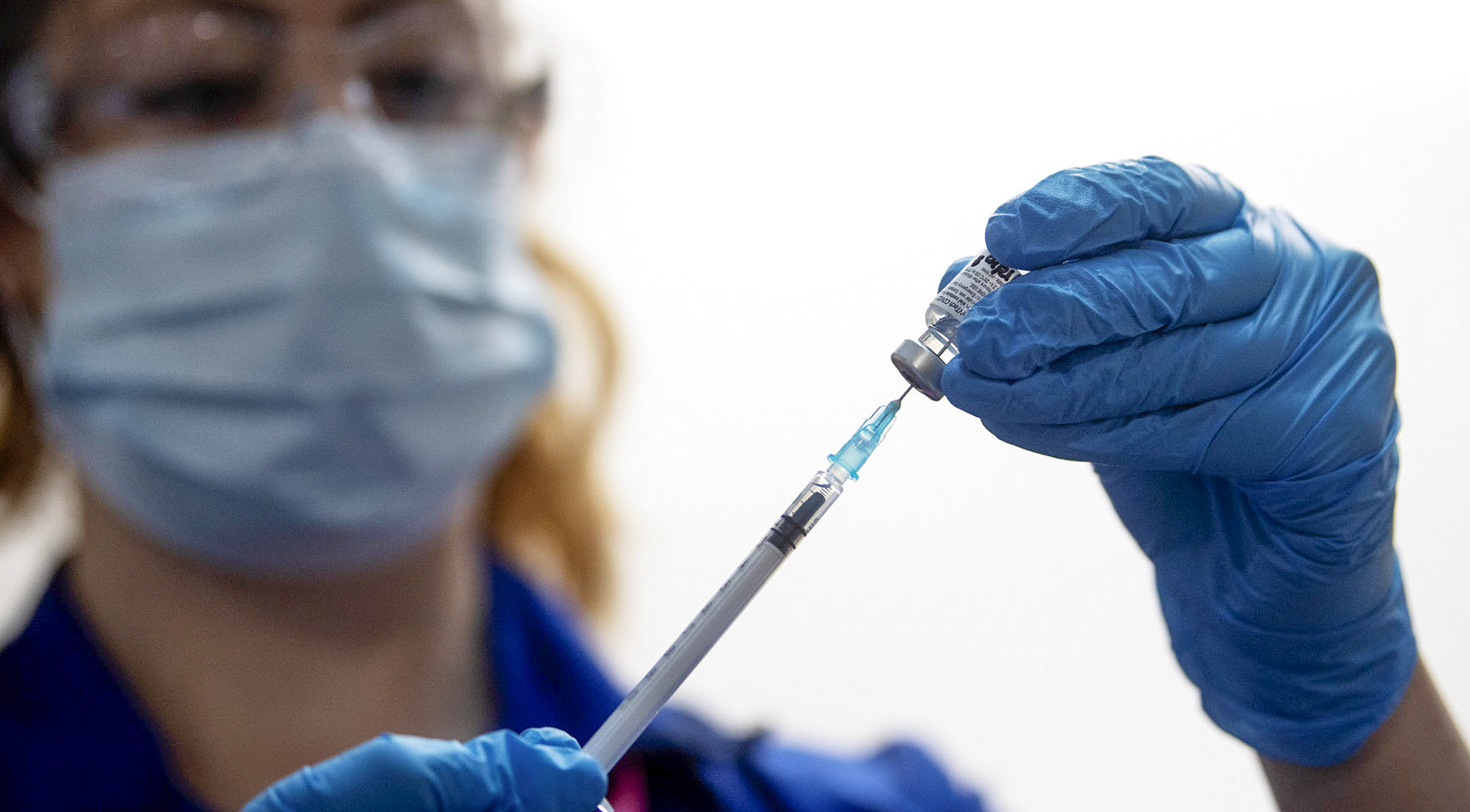Spotlight: Coronavirus
‘Sniper attack’: Inside the Western Cape trial of a potentially variant-proof vaccine

An experimental Covid-19 vaccine currently in Phase I trials run by the University of Cape Town has a unique design that might offer better protection against current and future variants of the SARS-CoV-2 virus. Here we provide an update on the trial and unpack the science behind this vaccine candidate.
In February, the University of Cape Town (UCT) announced that a group of its researchers was expected to start a Phase I clinical trial of an experimental Covid-19 vaccine produced by US company ImmunityBio. The experimental vaccine differs from current Covid-19 vaccines because it is designed to be more robust against the emergence of new variants.
Things have progressed significantly in the more than three months since then.
The second chair in the Department of Medicine at UCT and a co-investigator on the trial, Professor Graeme Meintjes, says the Phase I trial, which started in March at the Wellcome Centre for Infectious Diseases Research in Africa’s Khayelitsha clinical research site, is ongoing. Vaccines are usually only approved after findings from Phase III trials have been published.
He says the first two cohorts of 10 participants each have been enrolled and both received two subcutaneous injections of the vaccine, three weeks apart. One cohort received a higher dose.
“The purpose of that was to assess safety, so participants were followed up very carefully for side-effects and for reactions to the vaccine. And the review of that suggests no major safety concerns,” Meintjes says. He adds that the Phase I trial design has since been adapted to include four more cohorts. This has been approved by the South African Health Products Regulatory Authority (SAHPRA), but the UCT ethics committee still needs to approve this before they can continue.
The four additional cohorts will include people who have had Covid-19 because the researchers want to look at the effect the vaccine will have on boosting existing immunity against the disease. Each cohort will have 10 participants, bringing the expected total number of participants for Phase I to 60.
Routes of administration
Each person in these new cohorts will receive one dose of the vaccine, either through a subcutaneous injection, a sublingual method (the vaccine in a liquid form administered by being put under the tongue for a few minutes), a combination of subcutaneous injection and sublingual method, and an intranasal administration.
The researchers will measure whether a person’s immune system can be sufficiently boosted through these different routes of administration.
“We’ll be measuring the antibody responses as well as the T-cell responses to the vaccine, but we do not have results yet,” says Meintjes.
The trial will continue at the Khayelitsha clinical research site, with participants and volunteers coming from across Cape Town. “We would hope to complete enrolment within the next two months… pending approval from the ethics committee.”
Plan for Phase II/III trial
Meintjes confirms that plans are under way for a larger Phase II and Phase III trial in South Africa, which will be headed by the South African Medical Research Council.

The first two cohorts of 10 participants each have been enrolled and both received two subcutaneous injections of the ImmunityBio vaccine, three weeks apart. (Photo by Victoria Jones – Pool / Getty Images)
Details of the trial design will, however, only be made public once SAHPRA has given the green light for the trial to proceed. For example, it remains to be seen to which vaccines the ImmunityBio vaccine will be compared – we think it is unlikely that placebos will be used in future trials given that we already have vaccines that work very well.
What makes this vaccine different?
The ImmunityBio vaccine candidate differs in several ways from the Covid-19 vaccines currently in use, says Meintjes. The vaccine has been designed in a way that could potentially offer a broader immune response that is long-lasting. The potentially broader immune response provides the possibility of offering protection against future SARS-CoV-2 variants.
Meintjes explains that, right now, most of the Covid-19 vaccines are designed to produce an immune response against the spike protein of the virus. Yet, this particular part of the virus is prone to mutations, which have given rise to the different variants that have been seen worldwide.
According to the head of the Department of Clinical Virology at Lancet Laboratories, Professor Eftyhia Vardas, the spike protein is the part that sticks out of the surface of the virus. “[It] is used as the receptor binder. It’s like a lock and key mechanism that binds on your own cells… It binds to that, locks in, and actually infects the cells,” she explains.
To evade attacks by the immune system, the virus mutates and becomes unrecognisable to our immune system, she adds.
This often happens with other viruses, like the influenza virus, but the SARS-CoV-2 virus is very clever, says Vardas, because it is mutating at the spike protein, at the site where it binds with the human receptor cell.
Dual defence
The ImmunityBio vaccine seeks to combat the mutations in the spike protein by adding an extra line of defence. It aims to offer a two-pronged or dual defence, says Meintjes, because the vaccine contains two proteins from the SARS-CoV-2 virus.
The vaccine still contains the spike protein, as well as a more stable protein, the nucleocapsid.
The nucleocapsid, Meintjes says, is found on the inside of the virus and is involved in the packing of its genetic material. So far, the nucleocapsid of the SARS-CoV-2 virus appears to be less prone to mutation and remains more stable over time.
He explains that targeting the nucleocapsid could potentially provide more durable and long-term protection against different variants of the SARS-CoV-2 virus because the immune system will recognise the nucleocapsid even when the spike protein changes.
“The hope is that by including the nucleocapsid you would generate a vaccine response that covers emerging variants, those that have emerged and those that might emerge in the future,” he says.
A human adenovirus-based vaccine
“This vaccine comes packaged in a human adenovirus vector. It’s a modified viral vector,” says Meintjes.
Director of the Africa Health Research Institute, Professor Willem Hanekom, explains that in a viral vector vaccine like this one, a vector is basically just a carrier for the piece of the virus you want the immune system to respond to. He adds that a vector is needed to stimulate the immune system’s response, and a viral vector is effective because it is foreign to the immune system which will stimulate an immune response.
“What scientists do is they take these adenoviruses and they rip out their guts, they rip out the dangerous parts of them,” he says. “And they replace that with the parts of the virus that you want the immune system to see, so the parts of the coronavirus that you want the immune system to see… [then] the immune response that you develop is against that [part of the virus].”
In this case, the human adenovirus known as hAd5 is simply the carrier or vehicle that gets the two proteins of the SARS-CoV-2 virus into the body so it can be seen by the immune system.
However, according to Hanekom, if you have previous immunity against the adenovirus (which causes the common cold) being used in a vaccine because you have been exposed to it before, the immune system will destroy it before it is exposed to the SARS-CoV-2 proteins. This is why the human adenovirus used in the ImmunityBio vaccine (hAd5) has been modified, so it is now a second-generation adenovirus.
“They’ve modified the adenovirus so it will still work and still be seen by the immune system even if there is pre-existing immunity because they’ve taken out the parts that the pre-existing immunity sees,” he says.
Public health medicine specialist Nisha Naicker points out that the Johnson & Johnson Covid-19 vaccine already uses a human adenovirus known as Ad26, and the AstraZeneca vaccine uses a chimpanzee adenovirus.
Potentially stronger T-cell response
Using the nucleocapsid in the ImmunityBio vaccine might enhance the immune response to SARS-CoV-2 in other ways. Meintjes says the vaccine is specifically designed to elicit strong T-cell responses to the nucleocapsid, and such responses have been observed in animal studies.
“Obviously one purpose of these studies is to see whether this design element generates those strong T-cell responses in humans as well,” he says. “All Covid-19 vaccines elicit T- and B-cell responses, it’s not one or the other. But this (vaccine) is specifically designed to enhance those T-cell responses.”
Naicker explains that B-cells and T-cells are part of the body’s adaptive immune response, which is activated by the immune system being exposed to a foreign protein, in this case the SARS-CoV-2 virus. The first time your immune system is exposed to the virus, you will develop antibodies to it, through B-cells, she says. When you come into contact with the virus again, you already have those antibodies, in the form of memory B-cells.
“This is what a vaccine does. A vaccine contains an antigen (part of the virus) and once injected stimulates an immune response that will block or destroy a virus,” she adds.
Vardas says that with the ImmunityBio vaccine, B-cells and memory B-Cells will be formed that will remember the spike protein and the nucleocapsid and how to attack it. She likens this to a sniper attack. She explains that when a memory B-cell detects the spike or nucleocapsid protein, it signals for the production of B-cell antibodies. These antibodies then coat the outside of the virus, which signals the T-cells to attack and essentially “eat up” the virus-infected cells.
There are two types of T-cells, says Vardas – CD4 cells which attack the virus, and CD8 cells which also form a memory cell as the B-cell does. “You’ll have groups of CD4 and CD8 cells that are spike protein-specific and groups that are nucleocapsid specific, so improving that kind of attack to two sides of the war,” says Vardas. DM/MC
This article was produced by Spotlight – health journalism in the public interest.
"Information pertaining to Covid-19, vaccines, how to control the spread of the virus and potential treatments is ever-changing. Under the South African Disaster Management Act Regulation 11(5)(c) it is prohibited to publish information through any medium with the intention to deceive people on government measures to address COVID-19. We are therefore disabling the comment section on this article in order to protect both the commenting member and ourselves from potential liability. Should you have additional information that you think we should know, please email [email protected]"



 Become an Insider
Become an Insider